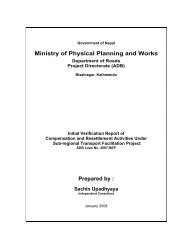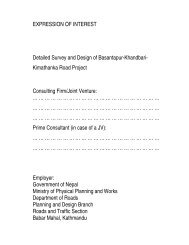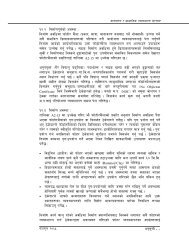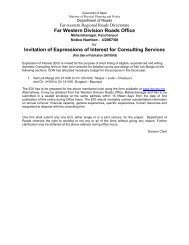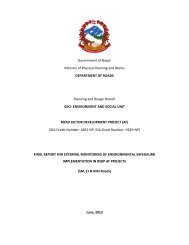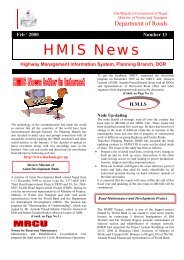Environmental & Social Management Framework - About ...
Environmental & Social Management Framework - About ...
Environmental & Social Management Framework - About ...
You also want an ePaper? Increase the reach of your titles
YUMPU automatically turns print PDFs into web optimized ePapers that Google loves.
<strong>Environmental</strong> and <strong>Social</strong> <strong>Management</strong> <strong>Framework</strong>• Climate and statistical data published by Bureau of Statistics• Other published documentation on these subjects.(b) Biological Resources• Scientific publications on local biota surveys• Species distribution maps• Ecological studies carried out in the project area (particularlywhen protected areas are in close vicinity, e.g. Rara Lake)• Direct observations carried out by specialized surveyors• Accounts on habitats and species given by local residentscontacted during public consultation processes• Other relevant documentation.(c) Socio-economic and Cultural Resources• Scientific publications on previous local surveys• Published demographic data and maps• Household surveys carried out by the Consultants Field Team1.4 Potential Users of this <strong>Environmental</strong> and <strong>Social</strong> <strong>Management</strong><strong>Framework</strong>The Report is prepared as an after due discussion with the Client at DOR and thedonor at the office of World Bank. It was advised to the Consultant to prepare thedocument in such a way that stakeholders affiliated or affected by the forthcomingsub-projects of the SRN, as well as other road projects of similar size andregional setting, will make use of this report in various aspects of managing theenvironmental and social implications during planning, design andimplementation of the envisaged program.The ESMF is applicable to all proposed subproject activities and through allstages of the subproject cycle, i.e. from pre-planning, planning and design,implementation to post-implementation. The design flow of ESMF activities willbe coordinated and integrated into the project cycle. This does not waive thenecessity of any project proponent to refer and comply with the nationalregulatory provisions as outlined in Chapter 2 of this ESMF.The mainstreaming of environmental and social aspects in the project cycle willbe achieved through:• Incorporation of environmental and social activities in the OperationalGuidelines for each sub-project.• Development of supportive programs in the areas of vulnerable communities’development, resettlement and rehabilitation, and monitoring and evaluation.• Establishment of appropriate institutional arrangements for environmentaland social impact management.• Development of a communications/information dissemination strategy.• In-house training and capacity building on environmental and social impactmanagement.• Intensive use and application of the guidelines prepared by previous effortsof the Geo-Environment Unit, namely the ‘<strong>Environmental</strong> <strong>Management</strong>Guidelines May 1997’, and the ’Reference Manual for <strong>Environmental</strong> and<strong>Social</strong> Aspects of Integrated Road Development, 2003’.• Intensive use and application of the ‘Roadside Bio-Engineering Manual 1999’prepared under DFID funding,• Intensive consultation of all documentation available on Good Practice inroad construction under local conditions, particularly referring to the ODAManual on ‘Principles of low cost road engineering in mountainous regions(ORN # 16) and other principles provided in Annex 2 of this document.Chapter 1-6 April 2007


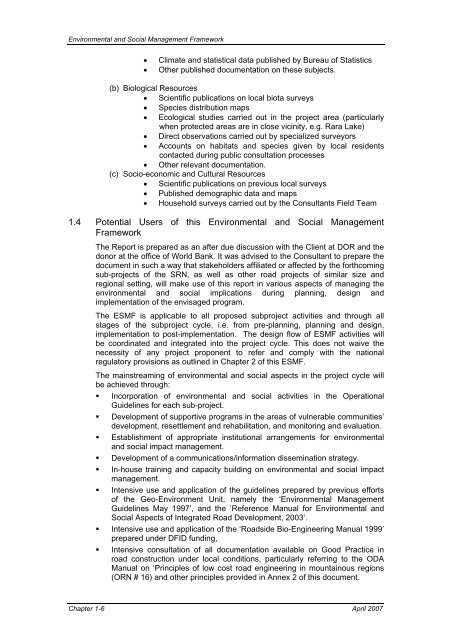
![j:6 ]zg cfof ]hgf](https://img.yumpu.com/51286794/1/190x245/j6-zg-cfof-hgf.jpg?quality=85)

![x'nfsL /fhdfu { cfof ]hgf](https://img.yumpu.com/50581959/1/190x245/xnfsl-fhdfu-cfof-hgf.jpg?quality=85)
